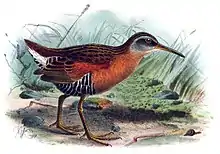Ecuadorian rail
The Ecuadorian rail (Rallus aequatorialis) is a species of bird according to the International Ornithological Committee (IOC), but other taxonomic systems treat it as a subspecies of the Virginia rail (R. limicola). It is in subfamily Rallinae of family Rallidae, the rails, gallinules, and coots. It is found in Colombia, Ecuador, and Peru.
| Ecuadorian rail | |
|---|---|
 | |
| Scientific classification | |
| Domain: | Eukaryota |
| Kingdom: | Animalia |
| Phylum: | Chordata |
| Clade: | Dinosauria |
| Class: | Aves |
| Order: | Gruiformes |
| Family: | Rallidae |
| Genus: | Rallus |
| Species: | R. aequatorialis |
| Binomial name | |
| Rallus aequatorialis Sharpe, 1894 | |
| Synonyms | |
|
Rallus limicola aequatorialis | |
Taxonomy and systematics
The IOC treats the Ecuadorian rail as a separate species with two subspecies, the nominate R. a. aequatorialis and R. a. meyerdeschauenseei. They base this treatment on Ridgely & Greenfield (2001).[1][2][3] However, the South American Classification Committee of the American Ornithological Society, the Clements taxonomy, and BirdLife International's Handbook of the Birds of the World (HBW) treat those two taxa as subspecies of the Virginia rail.[4][5][6]
This article follows the IOC model.
Description
The Ecuadorian rail is 20 to 21 cm (7.9 to 8.3 in) long and weighs about 85 g (3.0 oz). The sexes are alike. Adults have a long, slightly decurved, bill that is reddish brown with a bright orange base. Their legs are dull orange. They have brown upperparts with blackish streaking and much rufous on the wing coverts. Their face and the sides of the neck are bluish gray and their throat white. Their underparts are dull cinnamon-buff with black and white barring on the flanks.[3][7]
Distribution and habitat
The Ecuadorian rail is found in the Andes from extreme southern Colombia to southern Ecuador and coastally in Peru between the departments of La Libertad and Arequipa.[5] It inhabits marshes and wet grasslands at elevations up to about 2,400 m (7,900 ft).[3][7]
Behavior
Movement
The Ecuadorian rail is a year-round resident throughout its range.[7]
Feeding
The Ecuadorian rail mostly forages in vegetation but sometimes ventures slightly into more open areas early in the morning. Its diet has not been determined separately from that of the Virginia rail sensu lato. That species has an eclectic diet that includes adult and larval aquatic invertebrates of many kinds, amphibians, and plant material.[3][7]
Breeding
Details of the Ecuadorian rail's breeding biology are not known.[7]
Vocalization
As of late 2022, xeno-canto had no recordings of Ecuadorian rail vocalizations and the Cornell Lab of Ornithology's Macaulay Library had 10.[8] Its calls are described as "a descending series of squeals and grunts" with a higher pitch than those of the Virginia rail.[3]
Status
The IUCN follows HBW taxonomy and so has not assessed the Ecuadorian rail separately from the Virginia rail.
References
- Gill, F.; Donsker, D.; Rasmussen, P., eds. (August 2022). "Finfoots, flufftails, rails, trumpeters, cranes, Limpkin". IOC World Bird List. v 12.2. Retrieved August 9, 2022.
- Ridgely, Robert S.; Greenfield, Paul J. (2001). The Birds of Ecuador: Status, Distribution, and Taxonomy. Vol. I. Ithaca: Cornell University Press. ISBN 978-0-8014-8722-4.
- Ridgely, Robert S.; Greenfield, Paul J. (2001). The Birds of Ecuador: Field Guide. Vol. II. Ithaca: Cornell University Press. pp. 124–125. ISBN 978-0-8014-8721-7.
- Remsen, J. V., Jr., J. I. Areta, E. Bonaccorso, S. Claramunt, A. Jaramillo, D. F. Lane, J. F. Pacheco, M. B. Robbins, F. G. Stiles, and K. J. Zimmer. Version 24 July 2022. A classification of the bird species of South America. American Ornithological Society. https://www.museum.lsu.edu/~Remsen/SACCBaseline.htm retrieved July 24, 2022
- Clements, J. F., T. S. Schulenberg, M. J. Iliff, T. A. Fredericks, J. A. Gerbracht, D. Lepage, S. M. Billerman, B. L. Sullivan, and C. L. Wood. 2022. The eBird/Clements checklist of birds of the world: v2022. Downloaded from https://www.birds.cornell.edu/clementschecklist/download/ retrieved November 10, 2022
- HBW and BirdLife International (2021) Handbook of the Birds of the World and BirdLife International digital checklist of the birds of the world. Version 6. Available at: http://datazone.birdlife.org/userfiles/file/Species/Taxonomy/HBW-BirdLife_Checklist_v6_Dec21.zip retrieved August 7, 2022
- Conway, C. J. (2020). Virginia Rail (Rallus limicola), version 1.0. In Birds of the World (A. F. Poole and F. B. Gill, Editors). Cornell Lab of Ornithology, Ithaca, NY, USA. https://doi.org/10.2173/bow.virrai.01 retrieved November 23, 2022
- "Virginia Rail (South American) Vocalizations". Cornell Lab of Ornithology. Retrieved November 23, 2022.